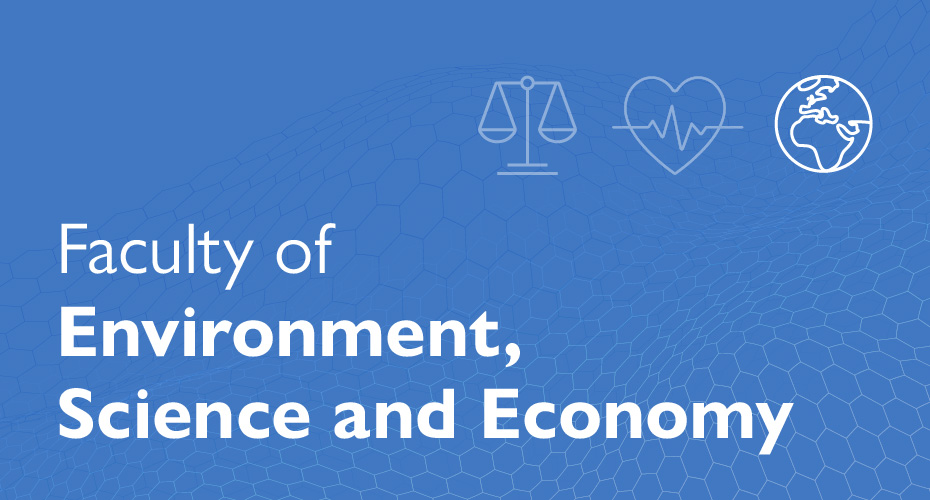Our structure: Strategy 2030
Our structure
Welcome: Professor Lisa Roberts, Vice-Chancellor and Chief Executive

Our new University structures launched in September 2022, and we are now organised into three academic faculties and eight professional services divisions.
When we embarked on this ambitious project to refine our organisational structures, we knew that we needed to build the strong foundations on which to deliver our Strategy 2030, our bold and inspiring vision to use the power of our education and research to lead the progress towards a greener, healthier, fairer future.
Now they are in place, these foundations are supporting more empowered and connected academic departments, allowing our faculties to be more resilient and agile in how they work, and enabling more local leadership and ownership for driving our strategic goals.
A key aim of this project was to encourage more interdisciplinarity and remove barriers to collaboration, so that conversations within and between faculties are now happening where previously they were not. This signals our wider intention to promote positive and permanent cultural change, so that we bring people of all academic disciplines together to face the big societal and global challenges of our time.
I truly believe that by doing this we have positioned ourselves in the strongest possible way to deliver our Strategy goals, and to continue building on our strengths for the future.
The change programme for our future structures formally came to a close in April, however key information regarding changes that took place during this period can be found in the links below.
I am incredibly excited to continue this new chapter for our University and would like to thank you for your continued support.
Strategy 2030 sets out our bold and inspiring vision to use the power of our education and research, to lead progress towards a sustainable, healthy and socially just future through our people, place and partnerships. The world faces very serious challenges and we intend to play our part by reframing the University to focus even more on our significant strengths and expertise in environment and sustainability, social justice and health and wellbeing in ways that are ambitious and clear, internally and externally. A brief overview of the change proposal is also covered in our Exec Summary
Key drivers of change
- The University almost doubled in size over the past ten years with staff numbers growing from around 3,000 to 5,000, students from 16,500 to 30,000, research income from £38M to £93M and turnover from £246M to £502M.
- We needed to become more agile and entrepreneurial while improving the student and staff experience. We heard from our colleagues and students that our structures had not kept pace with how the University was changing. Our previous structure was obscuring our purpose and priorities; hindering interdisciplinary working; and creating administrative burdens and duplication of governance.
- We consulted national and international opinion leaders who signalled that more substantial units were needed to drive discovery, insight, and solutions and to prepare the leaders of tomorrow while weathering any changes to the funding and policy environment.
After considering these factors, the University Executive Board, with engagement from experienced senior colleagues across all colleges, concluded that the academic and professional services structures which had served us so well over the last decade needed to evolve to help us deliver Strategy 2030. You can view the Consultation Report highlighting the feedback received and the rationale for any decisions made as a result.
By making these changes, we are now able to drive forward the new strategy with more clarity of purpose.
Why we wanted to change
By making changes to the way our academic and professional services structures are organised, we aimed to create:
- A simpler structure focused on our three strategic goals (Environmental Sustainability, Health and Social Justice), improving interdisciplinary opportunities for colleagues and students and improving our global reputation.
- Empowered academic departments with clearer accountability and local decision-making leading to a more inclusive learning community, a better student experience and vibrant research culture.
- Fewer departments enabling us to bring professional services support closer to our academic and learning communities with improvements to our students’ and colleagues’ experience as a result.
The Big Conversation identified a range of issues that were causing dissatisfaction amongst colleagues and students. We committed to building the foundations on which to resolve many of these, resulting in positive differences to the day-to-day working lives and careers of colleagues at all levels within the institution, as well as to the experience of students.
The benefits
Our approach built on our academic strengths, improving resilience, enabling more local ownership and delivery, enhancing agility, encouraging even more interdisciplinarity, and providing ownership for driving our strategic goals. It signals a new framework for wider operational and culture change to bring people together to face the big societal and global challenges of our time.
Benefits for colleagues:
- Academic colleagues are better supported to do their jobs, with closer professional services, locally available investment, engaged line management and less time spent on complex processes.
- Academic departments have embedded professional services department managers to support their activities and ambitions.
- There are more opportunities for colleagues to influence and contribute to decision making.
- There are even more opportunities for colleagues to partner and collaborate across the University and to lead projects that enhance career development and increase leadership opportunities.
- Professional services colleagues have fewer structures to navigate and can grow their knowledge and expertise of academic groups while building longer-term relationships.
Benefits for students:
- Creating cross disciplinary programmes working in collaboration to address the wants of ‘fairer, greener, healthier’ focused generations.
- An even better student experience delivered by colleagues who have the capacity and resources to support student needs.
- Streamlined systems and processes making the University easier to navigate with important services and information located closer to where students need them.
- More opportunities for working across disciplinary boundaries, by more easily undertaking cross-faculty and cross-university programmes with exposure to wider ranges of methodologies, facilities and experiences that will equip students for future careers.
- A stronger research culture enabling research students to gain greater interdisciplinary experiences including shared PhD programmes.
Institutional-level benefits:
- A stronger focus on the institutional strategy’s key themes with investment in larger, coherent groups with the power to shape their own destiny within University frameworks.
- Enhanced ability to grow and diversify research investment and funding.
- Ability to rapidly innovate in education and deliver a better student experience.
- Improved standing, political influence and reputation of ‘University of Exeter, Cornwall’, giving Cornwall a distinctive offer and clearer identity.
- More sustainable units giving more stability and flex to respond to external challenges.
- Leaner structures and broader spans of control, reduced governance overhead and duplication in business planning and strategy and streamlined processes leading to improved efficiency and improved staff wellbeing.
- Breaking down remaining barriers to interdisciplinarity, agility and creativity.
- Developing better cultures that support wellbeing and inclusion.
Outcomes and impacts of the re-organisation
Success will be measured across the 2030 timeline through:
- Development of measures to support supportive cultures, addressing our values (e.g. a new Culture Index);
- Improved student satisfaction (NSS), educational gain and employment outcomes;
- Stronger reputation and league table position;
- Improved income generation via student recruitment and interdisciplinary research and education;
- Improved colleague engagement, recruitment, reward and retention (inc. reducing pay gaps);
- Time and costs saved on governance;
- Increased investment in student and staff-facing roles enabled by reduced expenditure on senior leadership roles;
- More bottom-up ideas from colleagues and students being implemented;
- Increased net income for reinvestment in University priorities.
What does our new academic structure look like?
We have evolved our six colleges into three faculties, building on our academic strengths. Faculties comprise of departments, subjects, university research institutes and the Business School and Medical School. Each faculty supports a broad range of academic activities including elements of all three University strategic goals (Environment and Sustainability, Health, and Social Justice) and each acts as the champion for one of these. This approach safeguards our current diversity and promotes our longer term future. Our interdisciplinary strength continues to be built on strong disciplines and discovery research.
The names of the new faculties are as follows:
- Faculty of Health and Life Sciences (HLS)
- Faculty of Environment, Science and Economy (ESE)
- Faculty of Humanities, Arts and Social Sciences (HASS)
View our new senior leadership chart.
Cross faculty and university-wide initiatives
Our new structures makes cross-faculty working easier. Governance structures and working cultures promote, encourage and highlight collaborative working.
a) University-wide priorities and strategies
University strategies and associated priorities and goals (for example, strategic investments, improvements to National Students Survey (NSS),Teaching Excellence Framework (TEF), Research Excellence Framework (REF) or Knowledge Exchange Framework (KEF) scores or global engagement) are collectively owned by University Executive Board and led by an identified member, normally a Deputy Vice-Chancellor/ Pro-Vice-Chancellor or senior Professional Services Director. They work with Faculty Pro-Vice-Chancellors to ensure effective delivery of priorities. The Pro-Vice-Chancellor is accountable for the delivery of the priority in their faculty and the Head of Department is responsible for delivery in their department. Issues or new ideas raised in departments can quickly be considered by the Pro-Vice-Chancellor and escalated to University Executive Board in the new structures. Proposals for innovation and improvement are taken through the Pro-Vice-Chancellors/Deputy Pro-Vice-Chancellors/Head of Departments to identify leads in relevant departments (often a Director of Research/Education/Global etc.) and professional services support for implementation.
b) Cross-faculty collaboration
- Having three faculties (rather than six colleges) enables closer collaboration between the academic leaders in each domain (Pro-Vice-Chancellors, Deputy Vice-Chancellors / Associate Pro-Vice-Chancellors etc.) reducing complexity and barriers and making large-scale University-wide initiatives easier to achieve. Deputy Vice-Chancellors continue to facilitate cross-faculty work by using their strategic budgets.
- A key role for the Deputy Pro-Vice-Chancellors is to foster interdisciplinarity within and between faculties and they meet regularly to facilitate this and to remove barriers to achieving success.
- Cross-faculty research initiatives are also supported through Research Institutes and Research Networks and the proposed Exeter Futures Initiative. A key benefit for interdisciplinary working is the development of education programmes that cross departmental or faculty boundaries and which open new areas of opportunity for students, partners and colleagues. These are supported through the Deputy Pro-Vice-Chancellor network and increasingly through the new Exeter Education Innovation Institute.
- We expect to see new approaches to managing research technology facilities through a Research Technology Hub with shared governance for the major research facilities, with terms of reference and clear roles and responsibilities. The Deputy Vice-Chancellor Research and Impact is working on proposals to develop this.
The faculties are responsible for ensuring that the following types of cross-faculty activity are enabled:
- Major cross-University initiatives and big ideas.
- Shared modules offered to all Exeter students reflecting the three themes– e.g. sustainability, climate, proficiency in entrepreneurship, management or law, healthy living, gender rights, social justice.
- Enabling cross-institutional teaching delivery (financial, resource management).
- Growth of Degree apprenticeships, online/Continuing Professional Development/Exec Education, shared and delivered across faculties.
- Growth of Interdisciplinary PhD themes that cut across faculties.
- Greater visibility of core facilities at faculty level to support the overarching strategy themes.
- Sharing best practice in education and research.
- Joint faculty international student recruitment activities.
- Building existing and new relationships with partners within the context of the new strategy themes and establishing cross-faculty groupings to engage with key partners or particular business sectors.
Governance
The leadership structures are summarised in the table below. NB. The Taught Faculty and Doctoral College were not in scope for this reorganisation.
|
Body |
Who involved |
Role/ function |
|
University Leadership
University Executive Board (UEB) |
Vice-Chancellor Provost Deputy Vice-Chancellors Pro-Vice-Chancellors & Executive Deans Registrar Deputy Registrar Executive Divisional Professional Services Directors and Chief Digital Officer |
The University Executive Board (UEB) sets strategic priorities in agreement with the University Council and with input from the Senate. UEB shapes, monitors and ensures delivery of our institutional strategic plan, our sovereign strategies covering research, education, global and business engagement, major strategic investments and resources (through its Strategic Investment and Planning Committee – SIPC and its portfolio boards), and institutional performance against strategic targets.
UEB is chaired by the Vice-Chancellor and includes the Provost, Registrar and Secretary, Deputy Registrar, the Deputy Vice-Chancellors who oversee major strategic priorities, the Pro-Vice-Chancellors who are accountable for delivery of strategic priorities, the Chief Digital Officer and senior Professional Services Directors who manage underpinning systems and processes and support major priorities. |
|
Faculty Leadership Faculty Executive Board (FEB) |
Pro-Vice-Chancellor and Executive Dean (PVC) Deputy Pro-Vice-Chancellors Deputy Pro-Vice Chancellor & Dean (where a University Accredited School is present) Associate Pro-Vice-Chancellors Heads of Departments Institute Directors Director of Faculty Operations Senior Professional Services staff, representation from Cornwall
FEB may designate an agile senior team to take decisions in between formal meetings. |
The Faculty sets its own strategic plan, priorities, and objectives aligning all its constituent parts to University strategy and ensures delivery of its key performance indicators (KPIs) subject to agreement with the SIPC and UEB. It considers and approves the plans of its departments. Each Faculty is led by a Pro-Vice Chancellor and Executive Dean (PVC), reporting to the Provost. Each faculty has Deputy Pro-Vice-Chancellors who support the PVC in running the Faculty and also support a group of Departments. The PVC is also supported by Associate Pro-Vice-chancellors who are responsible for delivering the University’s sovereign strategies working with the Faculty’s departments. They report to the PVC with a dotted line to the relevant DVC. Professional Services strategic advice and support to the Faculty is provided through a Director of Faculty Operations and an administrative team who jointly line manages embedded Professional Services Partners underpinned by named experts who support departments. The Pro-Vice-Chancellor and Executive Dean is responsible for overall coordination of faculty activity agreeing arrangements for managing the faculty’s day-to-day business through the Associate Pro-Vice-Chancellors and Deputy Pro-Vice-Chancellors.
The Faculty is governed by the Faculty Executive Board (FEB), chaired by the PVC and is accountable to the Provost for performance, a positive inclusive culture and staff/student experience and for the delivery of the 2030 Strategy.. The Faculty Executive Board provides collective decision-making for the faculty and membership includes all the senior officers of the faculty including Deputy Pro-Vice Chancellor & Dean, Heads of Departments and Directors of Institutes.
The FEB decides strategic priorities, policies and targets within a common framework set by UEB. The FEB determines strategic investments to deliver priorities and gains agreement to these through SIPC. It promotes interdisciplinarity and an international mindset in research and education, identifies opportunities for development through external and internal partnerships, and supports well-being and inclusion of its staff and students in line with University values. The Faculty Executive Board sets the priorities for embedded and aligned professional services teams who will work to create a ‘one faculty’ approach in support of the faculty and its departments. Faculty priorities requiring cross-Faculty support can be agreed between faculties. If University-level financial support is required, proposals will go to UEB for consideration before consideration through normal SIPC channels. |
|
Department Leadership
Department Leadership Team (DLT) |
Heads of Departments Deputy Heads of department (in larger depts.) Directors of Research and Impact, Education and Student Experience, Global Engagement, Business Engagement and Innovation etc. Subject leads, Site Leads and other senior academic leaders Department Managers (PS) Aligned Professional Services support
DLT may designate an agile senior team to take decisions in between formal meetings. |
Departments are at the heart of the delivery of an inclusive culture and vibrant student and staff experience. The Departments are empowered to manage their activities and develop their own intellectual vision to deliver research and education academic programmes and the staff and student experience within the strategic and policy framework as set and agreed by the Faculty/ School or University. Within the department there may be several distinctive disciplines or major programmes/ research centres. They are led by a Head of Department.
It is the responsibility of the Head of Department to provide leadership and community support to the various elements of the department.
This could be provided through subject or site leads and other senior academic leaders who undertake line management of groups of people and ensure that disciplinary communities are maintained.
Professional Services support is provided through embedded Department Managers and administrative teams underpinned by named HR, Finance and Planning support and further aligned, named support from other Divisions. |
|
School Leadership School Leadership Team (SLT) |
Deputy Pro-Vice-Chancellor and Dean Associate Deans Heads of Department Lead PS Support for the School SLT may designate an agile senior team to take decisions in between formal meetings. |
The School develops its strategy to deliver school priorities within the faculty framework. Manages external accreditation processes and the staff and student experience. Manages external relationships.
Accredited University Schools (the University of Exeter Medical School and Business School) will be led by a Deputy Pro-Vice-Chancellor and Dean (DPVC/Dean) who reports to the PVC. They chair the School Leadership Team.
In Accredited University Schools more decisions and actions in thematic areas are undertaken on a cross-departmental basis led by an Associate Dean with fewer academic leadership roles in departments. |
|
Professional Services Leadership Professional Services Divisional Leadership team (PSDLT) Professional Services Leadership Team (PSLT)
|
Registrar and Secretary Deputy Registrar and Secretary Executive Divisional Directors Divisional Directors Directors of Faculty Operations Director of Cornwall Operations |
The Professional Services supports faculties and departments to develop and deliver their plans and enables the smooth operational management of the University. Professional Services Directors are committed to close engagement with academic leaders to support the academic endeavour. Some Professional services staff are embedded in and aligned to faculty structures working hand in hand with academics to support our ambitions in a ‘team ethos’. This supports rapid issue resolution and the co-creation of operational solutions. The Directors of Faculty Operations are jointly line managed by the Faculty Pro Vice-Chancellor and the Deputy Registrar and in turn they jointly line manage their senior professional services partners team with the Directors of the relevant Professional Service. Academic Heads of Department will jointly line manage their Professional Services Department Manager with the Director of Faculty Operations or their Deputy. The Registrar and Secretary chairs the Professional Services Divisional Leadership Team (PSDLT) and the wider Professional Services Leadership Team (PSLT) which coordinate activity across the Services. |
|
Senior Leadership Forum |
UEB members FEB senior academic members and DFOs, PSLT members. Chief Execs of the Students’ Guild and Student Union |
The Senior Leadership Forum (SLF) advises the Vice-Chancellor on matters relating to the strategy and management of the University, considers key policy issues affecting the University and provides an informal forum for the exchange of ideas, opinions and good practice. |
View the Education Governance model.
Faculty Leadership Roles
Faculty leadership arrangements have been designed to ensure that colleagues with responsibility for delivery are able to do so with appropriate authority and clear lines of accountability. Line management is undertaken by trained individuals covering appropriate spans of control. Overall, the number of leadership roles have decreased, reducing governance overhead. However, some new leadership roles have been established, creating new opportunities for colleagues. The roles featured in the new arrangements are summarised in the Faculty Structure Chart and described in the table below.
| Role | Description |
|---|---|
| Pro-Vice-Chancellor and Executive Dean |
The Pro-Vice-Chancellor & Executive Dean (PVC) is a full member of the University’s Executive Board and will play a key part in the continued success of the University. They share collective responsibility for the development and achievement of University Strategy and associated plans and will have a key external facing role representing the University and the faculty. The Pro-Vice-Chancellor & Executive Dean is accountable for the achievement of the University’s objectives and KPIs in relation to research, education, global and regional engagement for their faculty. They are responsible for the strategic vision, development and operation of the faculty’s education, research, global engagement, and business engagement through the effective leadership of staff and management of resources in pursuit of the strategic goals of both the University and the faculty. The Pro-Vice-Chancellor & Executive Dean has accountability for ensuring that their faculty achieves its academic and financial objectives. Each Pro-Vice-Chancellor & Executive Dean has executive responsibility in relation to the development and implementation of one of the three strategic cross-institutional themes (Wellbeing, Sustainability and Inclusivity). (Reports to the Provost) |
Deputy Pro-Vice-Chancellor and Deputy Pro-Vice-Chancellor and Dean |
Deputy Pro-Vice-Chancellor As a member of the Faculty’s Executive Board, the Deputy Pro-Vice-Chancellor (DPVC) will contribute to the effective leadership and management of the faculty and play a full role in its executive functions, delivering the strategic goals of faculty and departments and promoting interdisciplinary academic excellence. Working closely with and in support of the Heads of Department, the Deputy Pro-Vice-Chancellor is accountable for the delivery of key departmental KPIs (for example, in finance, student numbers, education outcomes and research and business funding and outputs). They are jointly responsible for shaping and successfully delivering the strategic direction of the academic disciplines within their remit, aligned with the strategic imperatives of the faculty and the University. Working with other Deputy Pro-Vice-Chancellors and Associate Pro-Vice-Chancellors within their faculty and across faculties to promote interdisciplinarity. As a member of the Faculty Executive Team, they will provide clear and effective leadership to the faculty, promoting a sense of collegiality, ambition, inclusion and a vibrant culture, encouraging productivity and ensuring the faculty delivers its agreed business plan. In agreement with the Pro-Vice-Chancellor, they will develop and deliver cross faculty (and potentially cross University) initiatives. They will deputise for Pro-Vice-Chancellor as required. Deputy Pro-Vice-Chancellor and Dean job descriptionDeputy Pro-Vice-Chancellor and Dean job descriptionDeputy Pro-Vice-Chancellor and Dean job description Deputy Pro-Vice-Chancellor and Dean In the case of the accredited Schools i.e. the Business or Medical School, the Deputy Pro-Vice-Chancellor is responsible for providing leadership and support to Heads of Department based in the school and will be known as the Deputy Pro-Vice-Chancellor and Dean. The Deputy Pro-Vice-Chancellor and Dean will be known as the Deputy Pro-Vice-Chancellor of the Faculty of X and Dean of the Y School. The Deputy Pro-Vice-Chancellor and Dean also line manages the Associate Deans. (Reports to the Pro-Vice-Chancellor) |
| Associate Pro-Vice-Chancellor (Education, Research, Global, Business Engagement and Innovation) |
The Associate Pro-Vice-Chancellor (APVC) plays a key role in supporting the Pro-Vice-Chancellor /Executive Dean in setting the direction of the faculty, providing faculty vision, direction and inspirational leadership for the academic development and delivery of the relevant strategy: The Associate Pro-Vice-Chancellors working together, and with their Deputy Vice-Chancellor have a key role in ensuring engagement with, shaping and delivery of the University’s relevant strategy and KPIs and will represent their specialism in external fora. Associate Pro-Vice-Chancellors will be supported by the team of “Directors of” in departments. Full proposals for these teams will be developed in discussion with Deputy Vice-Chancellors and new faculty teams once they are appointed. These will include senior leads for PGR support at faculty level and PGR leadership in departments. (Reports to the Pro-Vice-Chancellor with a dotted line to the relevant Deputy Vice-Chancellor) Associate PVC for Education job description Associate Dean for Research and Impact job descriptionAssociate Dean for Research and Impact job descriptionAssociate Dean for Research and Impact job description Associate PVC for Global Engagement job description Associate PVC for Business Engagement and Innovation job description |
| Faculty Director of Postgraduate Research |
The Faculty Director of PGR plays a key role in supporting the Associate Pro-Vice-Chancellor Research and Impact in leading on all aspects of PGR provision, policy and strategy within a faculty and contributing to the University strategy for Doctoral provision. |
| Associate Dean |
In the Business and Medical Schools, more of the activity of the departments will be coordinated at school level. There will therefore be new Associate Dean roles reporting to the DPVC and Dean and with a dotted line to the Associate Pro-Vice-Chancellor. The Associate Dean roles are: Business School Medical School Business School: Associate Dean for Education job description Associate Dean for Research and Impact job description Associate Dean for Global Engagement and Masters Programmes job descriptionAssociate Dean for Global Engagement and Masters Programmes job descriptionAssociate Dean for Global Engagement and Masters Programmes job descriptionAssociate Dean for Global Engagement and Masters Programmes job description Associate Dean for Business Engagement, Innovation and Professional EducationJD Medical School: Associate Dean for Education job description Associate Dean for Clinical Relationships job description |
| Director of Faculty Operations |
The Director of Faculty Operations will provide strategic leadership for all professional services within the faculty to ensure it meets its strategic objectives and that the embedded and aligned PS support creates the conditions for academic and student success. The Director of Cornwall Operations will work with the Deputy Vice-Chancellor Cornwall to ensure the effective management of the University of Exeter Cornwall. |
| Deputy Director of Faculty Operations |
The Deputy Director of Faculty Operations will provide clear strategic and operational leadership across the faculties and schools and will support the wider teams in these areas. |
| Head of Department |
The Head of Department (HoD) will provide leadership for the department and develop its strategy in line with University goals and aspirations. As a member of the Faculty’s Executive Board, they will also contribute to the effective leadership and management of the faculty, working collaboratively across departments and with other faculties. Larger departments may need Deputy Head roles, depending on their size/complexity. These could reflect major disciplines in the department, or campus location, and could take on elements of the Head of Department portfolio in agreement with the Head of Department and relevant Deputy Pro-Vice-Chancellor, deputising for the Head of Department as necessary. If a department has two main Subject areas the Head of Department may take the lead for one and a Deputy Head of Department for the other. The Head of Department is responsible for the delivery of key departmental goals (for example, in finance, student numbers, NSS, completion, graduate outcomes, education gain and research and business funding and outputs). They are jointly responsible for shaping and successfully delivering the strategic direction of the academic disciplines within their remit, aligned with the strategic imperatives of the faculty and the University. Part of their role will be to represent the department outside the University. As a member of the Faculty Executive Board, they provide clear and effective leadership to the department, promoting a sense of collegiality, ambition, inclusion and a vibrant culture, encouraging productivity, promoting interdisciplinarity and ensuring the department contributes to the delivery of the faculty’s agreed business plan. (Reports to Deputy Pro-Vice-Chancellor) Term 3(+2) years. |
| Director of Research and Impact/ Director of Education and Student Experience/ Director of Global Engagement/ Director of Business Engagement and Innovation/ Director of Postgraduate Research |
Works with the Head of Department to ensure that faculty strategies in their respective area are delivered. Depending on the department’s strategy, departments may want to strengthen some of these roles with deputies and in some cases one or more of these roles may not be needed. (Note that the role of Directors of Business Engagement and Innovation is still under discussion). (Reports to Head of Department) Director of Research and Impact job description Director of Education and Student Experience job description Director of Global Engagement job description |
| Department leadership structures |
Leadership structures within the department will be designed by the Head of Department and approved by the DPVC and Faculty Executive Board with the intention of making sure that appropriate line management and support is provided for all colleagues and in line with what is needed for that department. Deputy Head of Department job description Functions of senior academic leaders with line management responsibility |
| Strategic Professional Services Leads (HR, Finance, Research, Innovation, Philanthropy and Digital) | Embedded in the Faculty, Senior Professional Services Partners will provide strategic advice in their specialist areas to the Faculty Executive Boards, and coordinate activities and professional services teams in their specialisms aligned to departments/ disciplines/ clusters. Working closely with Faculty Executive Teams, Heads of Departments or their delegates. They also coordinate major University and faculty initiatives linked to their specialisms. Directors of professional services divisions will review current Business Partner arrangements and other aligned or central services to ensure they effectively support the new faculty structures and delivery of the University Strategy. |
Equality, Diversity, and Inclusion
We have looked at all structures through an Equalities Impact lens so that our structures do not lead to inequalities. We aim to create an inclusive culture, environment and sense of belonging, so that for example:
- There is an increase in diversity of perspectives in decision-making, including local decision-making structures.
- Larger units have fewer barriers and enable more interaction between our people, and more support and mentoring around EDI.
- A number of new roles enhance opportunity for career development and pathways to promotion.
- Leadership roles can be offered as job share and part-time arrangements.
- One of the Faculty Pro-Vice-Chancellor/Executive Deans is responsible for championing the strategic cross-institutional theme around inclusivity and social justice; we have a new management structure to support faculties – The Wellbeing, Inclusion and Culture Board.
- Faculty Executive Boards, chaired by the Pro-Vice-Chancellor and Executive Dean are accountable to the Provost for the creation of a positive, inclusive culture.
- Careful consideration is given to mix of characteristics and skills on faculty boards.
- Full leadership development is provided for staff taking on new leadership roles.
What our new professional services structure looks like
Professional services support is highly valued by academic colleagues and students, its structure evolved to ensure that academic and professional services colleagues work 'hand-in-hand' to support the delivery of Strategy 2030.
The new professional services structure was approved following the University-wide consultation, which was undertaken in 2022.
The structure responded to the future priorities of the new faculties and Faculty Pro-Vice-Chancellors and Executive Deans, as detailed below:
- Flexibility and resilience - a resilient and responsive professional service working in partnership with faculties, schools and departments.
- Team-based approach - flatter structures, reduced hierarchy and empowered staff.
- Local and accessible - closely aligned professional service resources to: support academic endeavour; develop and agree joint priorities and create a strong sense of belonging, allocating resource transparently and equitably with named contacts; reduced transactional costs and prioritise effective delivery.
- Reflecting scale and complexity - embed professional services leadership within faculties/schools, taking account of scale and complexity - continually asking how professional services can support academic teaching, assist research activity and improve student experience.
The new structure is designed to:
- Streamline and simplify – offer each service greater flexibility in their use of resources and increase cross-team working and break down silos.
- Align more closely with academic units – increase professional services alignment with the academic mission through embedded Professional Services Partners from each of the divisions, with all elements of professional services represented within Faculty Executive teams and dedicated Professional Services Department/School Managers (depending on the size and complexity of departments) with teams aligned to departmental needs.
- Enhance resilience – retain the focus on a single professional service, delivering the benefits of combined working, flexible resourcing and resilience to provide the best enabling support for our academic objectives. This will also enable organisational best practice and consistency across faculties and academic departments, as well as significantly supporting our professional services colleagues in the development of their career journey at Exeter.
Professional services is made up of eight divisions. You can find out more below:
Supporting the new faculties
Our professional services team’s ways of working were designed to support each of our new faculties - helping to shape each faculty’s strategic ambitions and providing robust support to each academic department.
To do this, we organised our professional services teams so that each faculty could draw on the expertise of colleagues from across our professional services. A number of our professional services colleagues are embedded within each faculty and/or department with dual reporting lines to each faculty and professional services team. Others are aligned to faculties, or particular departments, as named contacts, but they may also have other responsibilities. The key outcome is for a larger group of professional services colleagues to be aligned to each faculty so they are able to support the delivery of the ambitions set out in Strategy 2030.
Directors and Deputy Directors of Faculty
The Directors of Faculty Operations provide strategic leadership for all professional services within the faculty to ensure it meets its strategic objectives and that the embedded and aligned professional services support helps to deliver academic and student success.
Line management of the Directors of Faculty Operations is shared between the Faculty Pro-Vice Chancellor and Executive Dean and the Deputy Registrar.
Directors of Faculty Operations jointly line manage Professional Services Partners with their divisional professional service.
Meet our Directors of Faculty Operations
| Rachel Burn | Director of Faculty Operations, Faculty of Health and Life Sciences (HLS) |
| Clare Wydell | Director of Faculty Operations, Faculty of Environment, Science and Economy (ESE) |
| Tom Begbie | Director of Faculty Operations, Faculty of Humanities, Arts and Social Sciences (HASS) |
| Amie Fulton |
Director of Cornwall Operations |
Director of Faculty Operations job description
More information about our Directors of Faculty Operations can be found on faculty webpages.
Deputy Directors of Faculty Operations
The Deputy Directors of Faculty Operations provide clear strategic and operational leadership across the faculties and schools and support the wider teams in these areas.
Deputy Director of Faculty Operations job description
Professional Services Partners
Professional Services Partners are embedded within faculties and take part in Faculty Executive Boards. They help shape and co-create the faculty’s strategic direction and represent the very best in academic and professional services partnership working, forming multi-disciplinary teams to innovate, resolve issues and deliver together. They have joint reporting lines to the faculty via the Director of Faculty Operations and to their respective professional service to ensure shared identity with the faculty, whilst retaining all the benefits of being part of a single professional service.
The allocation of professional services partners and their teams has been flexed to suit the size and complexity of each faculty, working closely with the Pro-Vice Chancellors and Deans, Associate Pro-Vice-Chancellors and Heads of Departments and their teams.
Professional services partners coordinate annual faculty and department professional services support plans, and enable their resource and support needs to be regularly reviewed and more effectively fed into University planning processes, to reduce over-committing teams and to ensure resilient delivery.
Department / School Managers
As a result of the feedback from the earlier consultation, as well as the Big Conversation, the ‘Registrar for a Day’ and the Bonfire of Bureaucracy, we have invested in professional services managers for each school/academic department. As a result, the professional services alignment project has reprioritised £1M resource to fund Department/School Managers across the institution. This fundamental change in the professional services operating model ensures that departmental academic leadership teams have direct support from embedded professional services colleagues who are able to support the delivery of their departmental strategy.
Department/School Managers are key to connecting with and coordinating all the available professional services support on behalf of the Head of Department, in support of the department strategy. Department/School Managers have a detailed contextual understanding of, and insight into, the academic units in which they work. These crucial front-line operational roles are tied into the academic leadership and faculty professional services partners to provide close support to those who need it. They support operational delivery, department budgets, help with building communities, connecting with students and enhancing the department/discipline identity.
The Department/School Manager, and academic department leadership team, call upon named professional services colleagues from all relevant divisions to enable them to deliver on their department’s strategic plans.
Department/School Managers report directly to the Head of Department and the Director of Faculty Operations, or their Deputy, as appropriate.
All Department/School Managers are undertaking an Induction and Training Programme specifically for Department/School Managers during their first six months in the role. This programme covers all aspects of the University’s operations and enables them to deliver across their wide remit. This ensures the development of best practice and offer peer-to-peer support, as well as working collectively to support the transition to new structures and ways of working.
Arrangements for the recruitment, induction, training, performance development reviews (PDRs) and other line-management responsibilities for these colleagues, as well as other colleagues who are embedded or aligned, remain within the relevant professional services division because there is capacity for professional line management with appropriate accountability to ensure a resilient and consistent service. The divisions also support employees’ wellbeing and career development, where support and coaching can be more effectively provided.
Professional services managers ensure that there are full discussions and updates with faculties relating to any moves or changes to staff embedded or aligned in faculties or departments.
view Department Manager job descriptions
The overall Professional Services alignment diagram shows the overall model for how we support departments, ensuring strategic support and operational delivery is as close as possible to academic endeavour, embedding professional services colleagues and empowering them to work across areas of responsibility to create and deliver departmental strategies.









